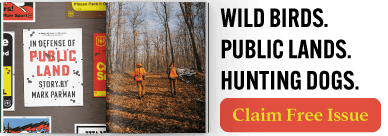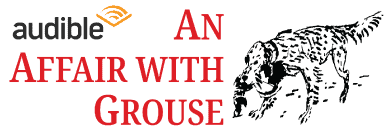Home » Hunting Videos » Get the Art – A Project Upland Original Film
Get the Art – A Project Upland Original Film

Durrell Smith is a Georgia native, visual artist, wing shooter,…
The Host of The Gun Dog Notebook brings us on his personal journey into the culture and dog life of the Red Hills in the Outdoor Life collaboration
Growing up I wasn’t so much a church kid as I was a kid whose great-grandfather helped build a church and whose grandmomma sang a ton of seraphic solos throughout the years. And for that, the word “Gospel” resonates with me in a very different manner. I spent countless Sundays listening to my grandmother blow from the choir stand as the red hue of the morning sunrise cut through the wrought iron bars in the windows. Voices throughout the morning rose as heatwaves did their shuck and jive on the pavement. Music changes and influences the atmosphere in a very special way here in Georgia.
This film is presented by Eukanunba Sporting Dog, Aya Fine Guns, and Dakota 283 Kennels.
I have spent about 20 years studying fine art and art history; I am really drawn to tracing modes of expression as humanity and groups of people evolve. It’s about developing a comprehensive documentation of human evolution through expression. As such, music and the arts are weighted with an incredibly powerful presence in every culture, especially that of the Red Hills region—specifically Thomasville, Georgia. The music, song, and dance came from Atlanta, but the spirit came from way deep in the piney woods. And it is deep in them woods that I join the early morning choir. It’s often men’s day in the woods, and “The Deacon,” Bob White, is singing his solo to the daybreak hymn.
I’ve never been a morning person, particularly at 2 a.m. while I’m loading dogs for the four-hour trip down south to Thomasville. But there’s something about the smell of coffee, the long road ahead, and the thought of stepping out there with my dogs that gets me up every single time. And by the time I pull into the Wildlife Management Area, the soloist is rallying for a chorus. They call from far off, and of course, I can never pinpoint their whereabouts.
Their song is a revenant. Proof that the birds are here.
I’m calling on my roots all the same as these noisy dogs sound like the hounds they once were. We all reach back and look for traces of our past. We do it for ourselves, we do it through the dogs, and we do it to acknowledge the trial and tribulation of a not-so-bygone era of the Jim Crow South, and the perseverance and prevail of the dogmen and plantation owners here who were able to transcend racial constructs to establish the foundation to bird dog history. There are great dogs in the Red Hills, some National Field Trial Champions, some touched by the hands of great men like Neal Carter, Jr.; Terry Chastain, Sr.; and a niche group of plantation dogmen who ran field trials and guided mule-drawn wagons through the lank of Pinus palustris.
But I’d been told by Neal himself, “The birds just move a little different down in that red clay.” I’m not sure I still fully understand these birds down here, although I try to anticipate what’s going on based on my dog’s body language. It takes a bit for a young dog to learn how to handle coveys down here. All the odds have to add up for the art of handling bird dogs to truly come alive. It’s much less technical and all about connecting simultaneously with the dogs and with the land.
On this day, I opted to put two dogs on the ground—Vegas and Ann—and they were working hard at a scent that wasn’t quite making sense that morning. It wasn’t too long before the birds flushed wild and took to the longitude of the pines. At 10 AM those birds just were clearly much more awake than me and the dogs.
Passing the cord
There’s a pride about the residences of the kennel dogs that folks run in Thomasville. As I walk across the gravel driveway into Neal Carter’s kennel, there is a moment of acknowledgment that it truly does mean something—not to just be in the winner’s circle at the Ga-Fla Shooting Dog Handler’s Club field trial, but more so to put in the work toward being there. It was Neal who truly revealed to me the discipline and discernment of handling the dogs. Each of the 11 dogs has their own unique relationship with him: they understand the routines and are always raring to go. Out of deference, I step aside as we walk to the dogs. Out of blind deference, I never open another man’s kennel gate.
He passes the check cord to me. And I make the crack that just about every one of his dogs is named Jake…
Dogs of the red clay
Visiting kennels has been a unique way to find a man’s true peace. Walking through Melrose’s kennels with Terry Sr., I am struck by the personal touch of actual distillery whiskey barrels for the dogs to sleep in after a hard day’s work in the field. It seems we all need a whiff of oak and bourbon after hours in the saddle or on foot. The dogs and the stories that accompany them make for the legacy of the line that one has started. I hope to write the narrative for my own dogs, curiously, in a vein that reflects a description I found of the type of dogs born out of the red clay. Many of them, residents of the Red Hills, are champions of the American Field. In the Ga-Fla Field Trial Club literature, Elsoma Plantation owner Charlie Chapin makes an interesting description of this type, stating:
The difference between great pointing dogs, field trial or gun dog, is mostly a matter of the jobs they are asked to do and trained for. The gene pool is identical, and one will not find a decent gun dog that does not trace within a few generations to multiple trial winners…They polish their gun dogs the same way they polish dogs they train for American Field sanctioned trials. Their task with gun dogs is a bit tougher, for it is truly hard to keep a spirited dog steady to shot when seeing birds fall.
I hear about those qualities in the stories of Neal’s favorite dog, Diamond, and Terry Chastain Sr.’s Melrose Huckabuck from the glorious days of his field trial career with scout Joe Fryson. And it’ll be one day that I pray to tell similar stories to my own children, of birds’ explosive flushes and broke dogs, developed and perfected over many seasons afield. The quail woods are a reflection of God in the sanctuary, and in my mind’s ear, I hear that ol’ lady, my grandmomma’s voice, her soul singing, breaking the morning light, in harmony with the breeze rattling the straws of south Georgian pine.
Call and response
The first Monday of March is the true apex of the season. The reconvening of the Ga-Fla Shooting Dog Handler’s Club is the mile marker for what development may or may not have taken place over the course of the year prior. Men and women from Albany, Quitman, Boston, Thomasville, and Tallahassee rise to honor the call of our forefathers. They come to laugh at dogs and men, for handlers to sing to their dogs, and for the woods to fill with the praises of top performers—but really, to elevate the glory and spirit of the South. There’s no other place like the Red Hills, where character and creed are determined in the piney woods, developed within the heart, and juried by the bird dogs themselves. And it is here where my story truly began, where each season I respond to the calling, where my passion was inspired, and my journey to getting and understanding the art of bird dogs becomes storied and penned to the script of the South as the Georgia heat turns cold.
Durrell Smith is a Georgia native, visual artist, wing shooter, and dog handler. While creating compelling ink and watercolor illustrations based on his field experiences and hunting dogs, he also runs The Sporting Life Notebook and the Minority Outdoor Alliance. As a first generation hunter, Durrell seeks to learn and contribute to the community by connecting with visionaries and veterans within the bird dog community who are willing to share stories and knowledge about the various breeds, creating a bridge to welcome new and novice dog handlers to the gun dog community.




Is this just part 1? Fantastic film, just wished it could have been a little longer. Thanks
love to hunt bird 🐦